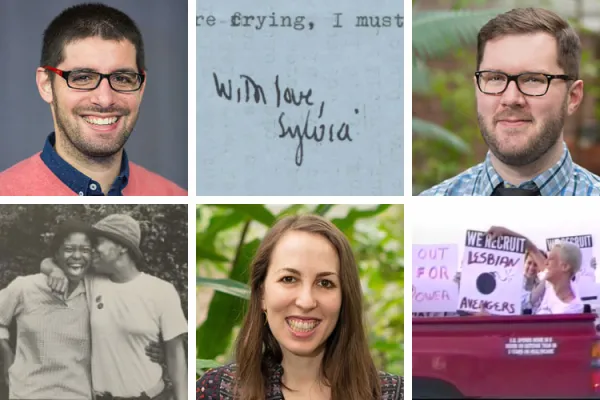Behind the Scenes: Libraries Staff Collaborate to Bring Archives Projects to Life
News

The Behind the Scenes series provides a unique look at the work of Libraries staff in Discovery & Access; Learning, Research and Technology; Administration; and Special Collections.
Published July 12, 2019
Kelly Anderson’s Taking the Archives Public seminar is an intense dive into the power of repositories; students must complete a complex public history project, culminating in a final digital or creative exhibit using material from Smith’s Special Collections. In order to equip students with the necessary technology and research skills, Anderson partnered with three Libraries staff members: Instructional Technologist Travis Grandy, Instructional Technology Specialist Mario Valdebenito Rodas, and Social Science Instruction Librarian Esther Roth-Katz.
“We discussed how to scaffold the process,” said Grandy, “especially for students who haven’t done digital humanities work before.” He describes digital humanities as using digital technology to conduct scholarship by creating or representing new knowledge, or creating tools that can be used for scholarly purposes.
As outlined in the class syllabus, students analyzed how archival materials become part of a meaningful and usable past for general audiences. Valdebenito explained how he and Grandy worked to help students find direction in sharing their analyses: “We developed several documents to guide students throughout the semester, such as the Design Process Handout. This document aimed to help students understand what was possible and guide the development of their ideas. Students could choose to create videos, podcasts, interactive maps or websites. Because there were many possibilities, we had to find ways to make these opportunities feel feasible for them.” Valdebenito and Grandy, who are members of the joint ITS-Libraries Learning, Research, and Technology (LRT) department, both provide pedagogical consultation out of the Learning & Design unit.
Roth-Katz is part of LRT as well, acting as a liaison to social science faculty and assisting students with research. “I let students know about the research guide I’d created for the class, and that there were resources available to them. I reinforced the point that they can make individual research appointments to talk about their projects with me,” she said. Roth-Katz also worked with Sophia Smith Collection Archivist Maureen Callahan to present a workshop for the course’s students, focusing on copyright and the implications of putting archival materials online. Additional Special Collections staff met with students as well: College Archivist Nanci Young provided guidance regarding access to college records, while Associate Curator Karen Kukil advised on a project exploring Sylvia Plath’s 1960s correspondence with her psychiatrist.
As the students began to form project ideas, Valdebenito and Grandy provisioned Wordpress sites for those whose projects would have an online component. “We instructed students in the development of their website by providing wireframing examples and exercises. We asked the class to analyze other websites paying attention to navigation and user experience,” said Valdebenito. “Each student had their own website, their own URL. We talked about creating menus, changing themes, and how to make design decisions always with the end user (a public-facing audience) in mind.” He and Grandy worked with students to organize their online content, add interactive elements, consider accessibility, and integrate user experience design.
Anderson, who is a lecturer in the Study of Women & Gender and in Archives, says she could not have taught the class without Grandy, Valdebenito, and Roth-Katz: “We really were a collaborative team and I think the projects are better this year because of that. The three of them went above and beyond-- from the extensive planning that went on with and without me, a really well-organized plan for class visits, their availability outside of class for individual consults, and the time we spent together in class workshopping technologies and/or their individual projects.”
So how did the final projects turn out? Grandy remembers cheering out loud at his desk when he saw some of the final work: “It was just really interesting to see these [Wordpress] tools that I use a lot every day being deployed in such a creative way. So that was really exciting.” The projects are a creative variety of interactive digital exhibits, online archives, and live performances, all of which bring unique archival materials to light. They explore gender, identity, sexual orientation, ethnicity, and the role of clothing in social roles. “It’s pretty impressive to see what they’re able to do in the confines of a semester,” said Roth-Katz.
Contact
Esther Roth-Katz
erothkatz@smith.edu
Learning & Design
academictechnology@smith.edu